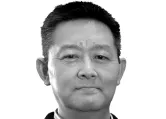Humans, machines, and outcomes
By Akira TokuhiroOn occasion of a Fukushima Daiichi nuclear power plant accident book-release1 event organised by a well-educated, secluded community in the Santa Ynez Valley (California), I came upon the above three words during a book-signing. Throughout human history of tool-making and energy-use (fire), then catapulted by currency-based commerce, the human use of "tools and energy" ever more sophisticated have determined the outcome of the human condition. Allow me to elaborate further on this theme.
At the end of 2015 and onward to 2016, a future unfolds as a result of newsworthy outcomes, most as a result of human "invention". Take for example the starkly contrasting recent events and outcomes in Paris. First, the well-planned, coordinated attack in Paris by ISIL (claimed) supporters/members was testimony to occurrences of the unexpected, though possible in these troubled times.
These adversarial activists/militants made full use of human inventions – weapons, computer hardware and software (via social networking), and via human-machine interaction changed the life outcome of many of its victims. Hardware/software provided the quick means to access and disseminate/distribute information to those who valued its (radicalised) content. Simply, weapons are the machines that human use – with an intended outcome.
Paris also hosted the recent COP21 Conference during protracted negotiations 196 nations signed an agreement to limit carbon emissions. This is in hope of thwarting the rise in global temperatures to below 2.0°C, deemed perilous to civilizations. Further the accord contains an 'intent' to make the global economy 'carbon neutral' by year 2100.
However, the outcome accord – an umbrella agreement of many-fold self-sovereign interests appears "toothless". It is voluntary, non-binding. In retrospect, we might humorously note that 'day 1' of climate change began with the human ability to start fire – converting identified materials (fuel) to energy and light.
Many eons later, the natural concentration/distribution of effluents in our biosphere is now skewed as a result of anthropogenic, accelerated use of fossil fuels to drive an industrialised, profit-driven global economy. The outcome is a complex socio-economic-technological challenge of global scale; that is, to counter and mitigate the (disputed) consensus negative impacts. We note that the accord itself – abstracted, is the common acceptance of information (written) by stakeholders (signatories).
The Institute of Defense Studies and Analyses2 also noted the COP21 as being 'toothless' since it is voluntary – thus maintaining the status quo – the profitability appears to preside over binding commitments. In fact, to maintain a profitable sovereign economy is seemingly an unsurmountable global driving force. Thus as IDSA noted, promoting coal-based external development while promoting renewable energy internally, presents a juxtaposed contradiction.
Undeniably, multi-nationals and stakeholder nations have campaigned to maintain the status quo via diplomacy of self-interest. In other words, we continue to decrease the complex, interconnected dynamics of fossil fuel-based socio-industrial economies of scales to simple profitability arguments. From a bird's eye view, this does not seem wise.
In fact, from an engineer's perspective, the "energy system" is Earth itself. The (thermodynamic) state of this system is increasingly askew and though controversially (human opinion), it is predicted to be on a dangerous path with unwanted outcomes. That is, the human ability to convert limited natural resources into energy and other forms is accomplished so efficiently to scale (the global economy), the state of the system (Earth) is itself threatened.
COP21 therefore calls upon all nations to shift away from the fossil fuel paradigm – a redirecting of the practices in use of resources, as response in a timely, agreed upon manner.
Many of us know that for well-designed (complex) engineered systems with inherent risks (airplanes, nuclear plants, etc.) human intervention into the state of the system, when malfunctioning, is needed using safety systems or resources in a timely manner. Otherwise, we face unknown outcomes, noted in risk research as "unknown and dreaded" risks.
At Fukushima Daiichi, as example, the state of three reactor units (having lost cooling) proceeded to a severe accident – a melting of the core and an unwanted outcome (release of radioactivity) because the resources needed to mount a response was inadequate.
Back to "mother Earth", anthropogenic activity has changed the system such that it has indications of being substantially off-normal. Although we live in the information era, our mindset is myopically profit-oriented, simplistic – an industrial revolution legacy. We are assuming that our Earth will be just fine even with its resources depleted.
This can be perceived as wise. Let us not reduce climate change and energy sustainability – complex issues and challenges – to one of profitability. Instead, at minimum let us talk in terms of a common set of metrics (LENDIT below) that facilitates discussion across both "hard" and "soft" domains. It is self-evident that a common set of metrics is needed.
So simply, LENDIT (metrics – length, energy, number, distribution, information, time) and S2R2 (systems, state, resources, response) are two overarching concepts I proposed in analyses of and communication on complex issues. In the context here it characterises the socio-technical aspects of energy as an anthropogenic enterprise.
As energy (E) is directly correlated to the standard of living (N, as currency), we have increasingly distributed (D) GHG-emitting engineered systems (N, as generating plants) in time (T), to an extent wherein information (I, as evidence) gained tells us that ocean level (L) and temperature (as reflection of E) will endanger civilisation.
Under such circumstance, the state of our system (S2) is askew and thus, we must rethink the use of our resources in timely response (R2). With this in mind, you will see the utility of LENDIT and S2R2 via words and concepts interspersed above.
In closing, although science, then engineering have greatly facilitated the standard of living, human history on our sole life-sustaining planet, with limited, finite resources and a delicate biodiversity tells us that over-focus on the status quo – profitability – points us toward an outcome that threatens our livelihood.
If so, let us not reduce the complex nature of the socio-industrial economies of scale to simple "N" arguments. Please consider using LENDIT and S2R2 in your work. Let us be respectful of mother Earth and reducing our effluent footprint.
______________________
1On the Brink – The Inside Story of Fukushima Daiichi. ISBN-10: 4902075547
2https://www.idsa.in/idsacomments/cop21-paris-agreement_dadwal-malaviya_181215




















 Advertise
Advertise






